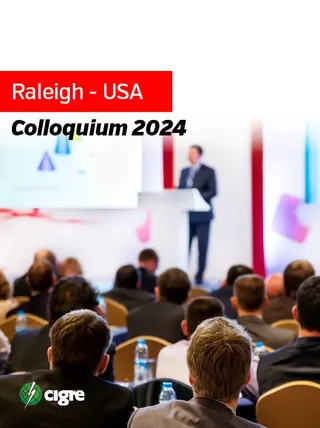Summary
2024 Grid of Future, Raleigh, NC
- 2024-1 - System-Wide Dynamic Protection Settings for Transmission Systems
- 2024-2 - A Review on Protection Challenges of Transmission Lines Connected to Inverter-Based Resources
- 2024-3 - Transmission Line Protection Under High Penetration of Inverter-Based Resources: Impact Assessments and Mitigation Solutions
- 2024-4 - Bridging the Gap Between Protection and Planning for Holistic Analysis of Transmission System Performance
- 2024-5 - Extreme Fast Charging: Overview of Technology and Grid Impacts, and Importance of Lab Testing to Mitigate Potential Issues and Enable Large-Scale Deployment
- 2024-6 - Managing High-Demand EV Fast Charging through Smart Charging and Energy Storage Integration: A SCE Case Study Demonstration
- 2024-7 - Vehicle-to-Grid Optimization via Quantum Annealing
- 2024-8 - State of the Art in Application of Multi-Port DC-DC Converter to EVs
- 2024-9 - Transient Stability Assessment of Utility-Scale System with Grid-Forming Battery Storage
- 2024-10 - Impact of Large Load Disconnection on System Stability
- 2024-11 - Building LLM-Powered Agent to Augment Quality Control in Reliability Planning of Distribution Grid
- 2024-12 - Utilizing Bi-Directional Distribution Level Power Flow Studies to Illustrate Effects of DER on the Electric Distribution Grid
- 2024-13 - Enhancing Power Flow Management in a New England System with High IBRs Using m-SSSC and PST Integration
- 2024-14 - Practical Applications of Near-Instantaneous Bi-Directional Power Flow
- 2024-15 - Practicality of Superconductors in Power Transmission
- 2024-16 - Beyond the Surface: The Strategic Advantages and Growing Need for Submarine Power Cables
- 2024-17 - Failover Redundancy Mechanism Ensuring Hitless Communications for Line Differential Protection
- 2024-18 - Demonstrating Segment Routing Potential for Utility IP/MPLS Networks
- 2024-19 - Distribution Workforce of the Future: Needs and Solutions
- 2024-20 - Accelerated FLISR Rollout to Improve Company Reliability
- 2024-21 - Bulk Power System Dynamic Contingency Manager – Chilean Grid Case Study
- 2024-22 - Comparison of Different Line Models for Switching Overvoltages Simulations
- 2024-23 - Identification of Impact Regions for Adaptive Distribution System Modeling in Transmission-Level Dynamic Contingency Analysis
- 2024-24 - Regional Grid Inertia Estimation and Frequency Nadir Prediction Considering Renewable’s Fast Frequency Response
- 2024-25 - Reverse Power Flow in Transformers
- 2024-26 - Application of Probabilistic Bayesian Networks on Transformer Condition Assessment
- 2024-27 - Evaluating the Impact of Multiple DER Aggregators on Wholesale Energy Markets: A Hybrid Mean Field Approach
- 2024-28 - Visions and Challenges for DER Participation in Electric Markets: A Distribution Perspective
- 2024-29 - Seasonal Overload Mitigation in Rural Distribution Feeders using Mobile Energy Storage System
- 2024-30 - Hosting Capacity Enhancement Strategies Using Data Analytics & Automation
- 2024-31 - Comparative Analysis of IBR Voltage Control for DER Hosting Capacity
- 2024-32 - Optimal Collector System Configuration for Utility-Scale Renewable Energy Projects
- 2024-33 - Practical Time Synchronization Design for Substations
- 2024-34 - Implementation of the Automated Relay Testing and Management Solution: Application and Use Cases
- 2024-35 - Criteria and Evaluation for an Event Record Retrieval System
- 2024-36 - Benefits and Recommendations for Using Classic Protection Functions in Transmission Lines Interfacing IBRs Compliant to IEEE 2800
- 2024-37 - Solving the Unit Commitment Problem Utilizing a Hybrid Quantum-Classical Computing Method
- 2024-38 - Transmission System Impact Evaluation and Mitigation Method for Public Safety Power Shutoffs
- 2024-39 - Measuring Risk in the Grid with Marginal Metrics
- 2024-40 - Adoption of Network Model Management in the North American Power Industry
- 2024-41 - Evolving Planning Criteria for a Sustainable Power Grid
- 2024-42 - The Impact of U.S. Reindustrialization on the Power Demand
- 2024-43 - Utility Resource Planning for Electric Vehicles & Beneficial Electrification
- 2024-44 - Towards a Greener Grid: Sustainable Methods in Substation Design and Construction
- 2024-45 - Comparing Advanced Cores – Achieving Maximum Grid Capacity
- 2024-46 - In-Situ Application of Capacity Enhancing Photonic Coatings to Overhead Conductors: Static Re-rating without Reconductoring
- 2024-47 - Conductor Icing Risk Assessment and Detection with Weather and Position Monitoring
- 2024-48 - Automated Method for Transmission Line Constants Calculation to Improve Efficiency and Accuracy
- 2024-49 - Transforming Protection & Control (P&C) Data: ConEdison’s Approach to Data Alignment
- 2024-51 - Electrical Characterization of Vegetation Contacts with Medium Voltage Conductors: Summary of Field Experiments
- 2024-52 - National Grid Pilot of Phase-EQ Technology
- 2024-53 - A Framework for Transfer Capability Analysis in Power Systems: An Automated Approach
- 2024-54 - Generator Prioritization for Voltage Control Based on Bus Voltage Sensitivity
- 2024-55 - Keep Your Grid Model to Yourself: Co-simulation for Multi-entity Planning and Simulation Without Needing Detailed Model Exchange
- 2024-56 - A System Architecture for Wildfire Situational Awareness Using Artificial Intelligence and Remote Sensing
- 2024-57 - Insights from PJM Interconnection’s Exploration of Artificial Intelligence
- 2024-58 - Enhancing Testing Strategies for Machine Learning, Digital Twin, and Artificial Intelligence Applications in Power Systems: A Risk-Based Approach
- 2024-59 - Advancing Power Grid Intelligence: Integrating Data Models and Real-Time Analytics for Improved System Management and Operation
- 2024-60 - Interconnected Ground Grids and Their Design – A Case Study
- 2024-61 - Benefits of Automated Overcurrent Protection Analysis of Distribution Grids
- 2024-62 - A System Design Framework for Wildfire Risk Management in Electric Utilities
- 2024-63 - A Quantitative Wildfire Risk Assessment Framework for Electric Utilities
- 2024-64 - A Novel Approach to the Determination of Asset Criticality and its Use in Asset Replacement Planning
- 2024-65 - Storage as a Transmission Asset in the Grid of the Future: Usage and Business Cases of BESS
- 2024-66 - ABCs of Asset Investment Planning
- 2024-67 - Load Forecasting Analysis for a Small Island Utility: Identifying Challenges to a Modernizing Grid
- 2024-68 - Comprehensive Cybersecurity Technology for Critical Power Infrastructure AI-Based Centralized Defense and Edge Resilience
- 2024-69 - Monitoring and Detection of Anomalies on Power Network Equipment Via SNMP and Syslog Can Pay Dividends
- 2024-70 - Development of an Active Power Malicious Attack Identification Using Dynamic Thresholding with a Long-Short Term Memory Algorithm
- 2024-71 - ÉCLAIR: A High-Fidelity Aerial LiDAR Dataset for Semantic Segmentation
- 2024-72 - Direct Transfer Trip Implementation for Multi-terminal Lines Using IEC61850
- 2024-73 - Unified Grid Control Platform Requirements of Process Bus Test Results
- 2024-74 - Leveraging IEC 61850 Functional Simulation to Reduce Risk, Cost, and Development Time in Every Phase of a Distributed Automation System
- 2024-75 - Control of 61850 GOOSE Lockout Relays via HMI Visualization
- 2024-76 - High-Fidelity Synchronized Measurements to Support Grid Resiliency and Asset Management in Puerto Rico
- 2024-77 - LUMA Energy Large Scale Distribution Feeder Protection Modernization Project
- 2024-78 - Planning Synchronized Measurement Technology Deployment in LUMA Energy
- 2024-79 - Voltage Optimization under High Renewable Penetration: Tackling Reactive Power Challenges
- 2024-80 - ComEd’s Commissioning a Digital Smart Substation (DSS)
- 2024-81 - Virtual Protection Relay: Quantifying the Reality
- 2024-82 - Migrating to Software-defined Architectures for T&D Substations
- 2024-83 - Towards the Digitalization and Virtualization of Power Grids
- 2024-84 - LUMA’s AMI Journey: Leveraging Technology and Data Analytics
- 2024-85 - The Challenges and Best Practices of Capturing Utility Asset Data for Puerto Rico
- 2024-86 - Asset Condition Assessment: Using Asset Information to Inform Risk-Based Decisions
- 2024-87 - Leveraging Small-Signal Analysis to Address Dynamic Stability in Inverter-Based Resource Dominated Networks
- 2024-88 - Data-Driven Inverter-Based Resources Short Circuit Modelling Using Deep Learning
- 2024-89 - Beyond EMT Model Collection: Model Validation and Use
- 2024-90 - EMT Model Development and Power Quality Investigation of a Utility Solar Site
- 2024-91 - Microgrid Challenges: Research and Tribal Community Perspectives
- 2024-92 - Cost-Benefit Assessment of MBB-Based Microgrids
- 2024-93 - Empowering Grid Resilience: Leveraging Distributed Energy Resources
- 2024-94 - A Practical Protection Scheme for a Partial Feeder Microgrid with Dynamic Point of Common Coupling
- 2024-95 - Impact of Geomagnetically Induced Currents on Differential Protection for Transmission-Level Transformers
- 2024-96 - Observed Effects of Geomagnetic Disturbances from Wide Area Monitoring System
- 2024-97 - Impact of Characteristics of GIC Signature on Thermal Effects of GIC on Power Transformers
- 2024-98 - Enhancing Power Grid Utilization and Reliability: Simulation and Cost Models for Advanced Power Flow Control Technologies
Additional informations
| Publication type | Colloquia |
|---|---|
| Reference | COLL_RAL_2024 |
| Publication year | |
| Publisher | CIGRE National Committee |
| Price for non member | Free |
| Price for member | Free |




